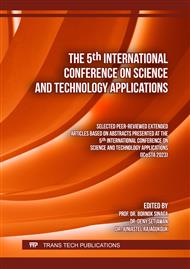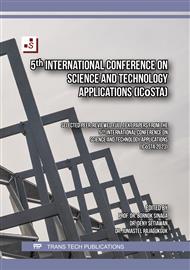[1]
S. D. Pardeshi, S. E. Autade, and S. S. Pardeshi, Landslide Hazard Assessment: Recent Trends and Techniques, Springerplus 2, 1 (2013).
DOI: 10.1186/2193-1801-2-523
Google Scholar
[2]
M. Alvioli, M. Melillo, F. Guzzetti, M. Rossi, E. Palazzi, J. von Hardenberg, M. T. Brunetti, and S. Peruccacci, Implications of Climate Change on Landslide Hazard in Central Italy, Sci. Total Environ. 630, 1528 (2018).
DOI: 10.1016/j.scitotenv.2018.02.315
Google Scholar
[3]
L. Selmi, T. S. Canesin, R. Gauci, P. Pereira, and P. Coratza, Degradation Risk Assessment: Understanding the Impacts of Climate Change on Geoheritage, Sustainability 14, 4262 (2022).
DOI: 10.3390/su14074262
Google Scholar
[4]
J. Zhou, P. Cui, and X. Yang, Dynamic Process Analysis for the Initiation and Movement of the Donghekou Landslide-Debris Flow Triggered by the Wenchuan Earthquake, J. Asian Earth Sci. 76, 70 (2013).
DOI: 10.1016/j.jseaes.2013.08.007
Google Scholar
[5]
W. J. Burns, N. C. Calhoun, J. J. Franczyk, E. J. Koss, and M. G. Bordal, Estimating Losses from Landslides in Oregon, Landslides Putt. Exp. Knowl. Emerg. Technol. into Pract. Assoc. Environ. Eng. Geol. (AEG), Spec. Publ. 27, 473 (2017).
Google Scholar
[6]
R. Huang and X. Fan, The Landslide Story, Nat. Geosci. 6, 325 (2013).
Google Scholar
[7]
D. B. Kirschbaum, R. Adler, Y. Hong, S. Hill, and A. Lerner-Lam, A Global Landslide Catalog for Hazard Applications: Method, Results, and Limitations, Nat. Hazards 52, 561 (2010).
DOI: 10.1007/s11069-009-9401-4
Google Scholar
[8]
F. Guzzetti, A. Carrara, M. Cardinali, and P. Reichenbach, Landslide Hazard Evaluation: A Review of Current Techniques and Their Application in a Multi-Scale Study, Central Italy, Geomorphology 31, 181 (1999).
DOI: 10.1016/s0169-555x(99)00078-1
Google Scholar
[9]
T. Hamza and T. K. Raghuvanshi, GIS Based Landslide Hazard Evaluation and Zonation–A Case from Jeldu District, Central Ethiopia, J. King Saud Univ. 29, 151 (2017).
DOI: 10.1016/j.jksus.2016.05.002
Google Scholar
[10]
B. Pradhan and A. M. Youssef, Manifestation of Remote Sensing Data and GIS on Landslide Hazard Analysis Using Spatial-Based Statistical Models, Arab. J. Geosci. 3, 319 (2010).
DOI: 10.1007/s12517-009-0089-2
Google Scholar
[11]
M. Yanis, N. Zaini, I. Novari, F. Abdullah, B. G. Dewanto, M. Isa, M. Marwan, M. Zainal, and A. Abdurrahman, Monitoring of Heat Flux Energy in the Northernmost Part of Sumatra Volcano Using Landsat 8 and Meteorological Data, Int. J. Renew. Energy Dev. 0, (2022).
DOI: 10.14710/ijred.2023.47048
Google Scholar
[12]
B. G. Dewanto, R. Priadi, L. S. Heliani, A. S. Natul, M. Yanis, I. Suhendro, and A. M. Julius, The 2022 Mw 6.1 Pasaman Barat, Indonesia Earthquake, Confirmed the Existence of the Talamau Segment Fault Based on Teleseismic and Satellite Gravity Data, Quaternary 5, 45 (2022).
DOI: 10.3390/quat5040045
Google Scholar
[13]
S. Hammami, L. Zouhri, D. Souissi, A. Souei, A. Zghibi, A. Marzougui, and M. Dlala, Application of the GIS Based Multi-Criteria Decision Analysis and Analytical Hierarchy Process (AHP) in the Flood Susceptibility Mapping (Tunisia), Arab. J. Geosci. 12, 1 (2019).
DOI: 10.1007/s12517-019-4754-9
Google Scholar
[14]
M. Zainal, B. Munir, and Marwan, The Electrical Resistivity Tomography Technique for Landslide Characterization in Blangkejeren Aceh, in Journal of Physics: Conference Series (2021).
DOI: 10.1088/1742-6596/1825/1/012022
Google Scholar
[15]
M. Zainal, B. Munir, M. Marwan, M. Yanis, and A. Muhni, Characterization of Landslide Geometry Using Seismic Refraction Tomography in the GayoLues, Indonesia, J. Phys. Its Appl. 3, 148 (2021).
DOI: 10.14710/jpa.v3i2.10601
Google Scholar
[16]
S. Lee, Application of Likelihood Ratio and Logistic Regression Models to Landslide Susceptibility Mapping Using GIS, Environ. Manage. 34, 223 (2004).
DOI: 10.1007/s00267-003-0077-3
Google Scholar
[17]
M. P. Kakavas and K. G. Nikolakopoulos, Digital Elevation Models of Rockfalls and Landslides: A Review and Meta-Analysis, Geosciences 11, 256 (2021).
DOI: 10.3390/geosciences11060256
Google Scholar
[18]
M. R. Mansouri Daneshvar, Landslide Susceptibility Zonation Using Analytical Hierarchy Process and GIS for the Bojnurd Region, Northeast of Iran, Landslides 11, 1079 (2014).
DOI: 10.1007/s10346-013-0458-5
Google Scholar
[19]
J. D. Bennett, N. R. Bridge, A. Djunuddin, S. A. Ghazali, D. H. Jeffery, W. Keats, N. M. S. Rock, S. J. Thompson, and R. Whandoyo, The Geology of the Banda Aceh Quadrangle, Sumatra-Geological Research and Development Centre, Bandung, Explan. Note 19 (1981).
Google Scholar
[20]
Y. Yin, W. Zheng, Y. Liu, J. Zhang, and X. Li, Integration of GPS with InSAR to Monitoring of the Jiaju Landslide in Sichuan, China, Landslides 7, 359 (2010).
DOI: 10.1007/s10346-010-0225-9
Google Scholar
[21]
B. T. Pham, D. Tien Bui, H. R. Pourghasemi, P. Indra, and M. B. Dholakia, Landslide Susceptibility Assesssment in the Uttarakhand Area (India) Using GIS: A Comparison Study of Prediction Capability of Naïve Bayes, Multilayer Perceptron Neural Networks, and Functional Trees Methods, Theor. Appl. Climatol. 128, 255 (2017).
DOI: 10.1007/s00704-015-1702-9
Google Scholar
[22]
Y. L. Ekinci, M. Türkeş, A. Demirci, and A. E. Erginal, Shallow and Deep-Seated Regolith Slides on Deforested Slopes in Çanakkale, NW Turkey, Geomorphology 201, 70 (2013).
DOI: 10.1016/j.geomorph.2013.06.008
Google Scholar
[23]
L. Claessens, G. B. M. Heuvelink, J. M. Schoorl, and A. Veldkamp, DEM Resolution Effects on Shallow Landslide Hazard and Soil Redistribution Modelling, Earth Surf. Process. Landforms J. Br. Geomorphol. Res. Gr. 30, 461 (2005).
DOI: 10.1002/esp.1155
Google Scholar
[24]
E. A. C. Abella and C. J. Van Westen, Qualitative Landslide Susceptibility Assessment by Multicriteria Analysis: A Case Study from San Antonio Del Sur, Guantánamo, Cuba, Geomorphology 94, 453 (2008).
DOI: 10.1016/j.geomorph.2006.10.038
Google Scholar
[25]
Y. Bamutaze, Morphometric Conditions Underpinning the Spatial and Temporal Dynamics of Landslide Hazards on the Volcanics of Mt. Elgon, Eastern Uganda, in Emerging Voices in Natural Hazards Research (Elsevier, 2019), p.57–81.
DOI: 10.1016/b978-0-12-815821-0.00010-2
Google Scholar
[26]
T. H. Mezughi, J. M. Akhir, A. G. Rafek, and I. Abdullah, Landslide Susceptibility Assessment Using Frequency Ratio Model Applied to an Area along the EW Highway (Gerik-Jeli), Am. J. Environ. Sci. 7, 43 (2011).
DOI: 10.3844/ajessp.2011.43.50
Google Scholar
[27]
F. C. Dai and C. F. Lee, Landslide Characteristics and Slope Instability Modeling Using GIS, Lantau Island, Hong Kong, Geomorphology 42, 213 (2002).
DOI: 10.1016/s0169-555x(01)00087-3
Google Scholar
[28]
J. Zhuang, J. Peng, J. Iqbal, T. Liu, N. Liu, Y. Li, and P. MA, Identification of Landslide Spatial Distribution and Susceptibility Assessment in Relation to Topography in the Xi'an Region, Shaanxi Province, China, Front Earth Sci 9, (2015).
DOI: 10.1007/s11707-014-0474-3
Google Scholar
[29]
R. C. De Rose, Slope Control on the Frequency Distribution of Shallow Landslides and Associated Soil Properties, North Island, New Zealand, Earth Surf. Process. Landforms 38, 356 (2013).
DOI: 10.1002/esp.3283
Google Scholar



